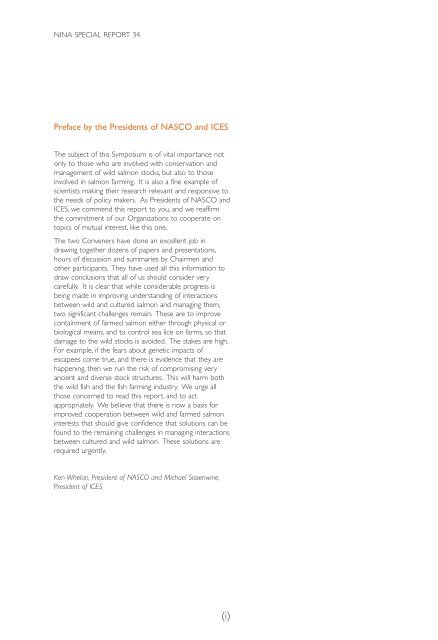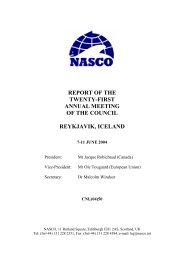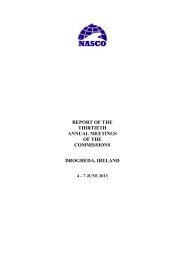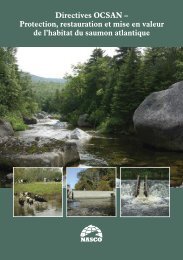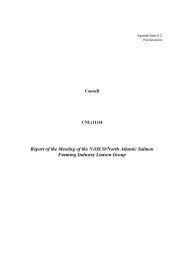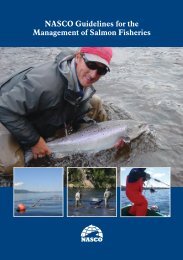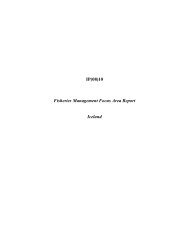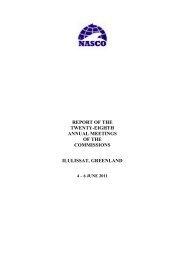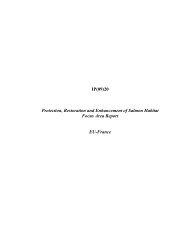Report of the 2005 ICES/NASCO Symposium on Interactions ...
Report of the 2005 ICES/NASCO Symposium on Interactions ...
Report of the 2005 ICES/NASCO Symposium on Interactions ...
You also want an ePaper? Increase the reach of your titles
YUMPU automatically turns print PDFs into web optimized ePapers that Google loves.
NINA SPECIAL REPORT 34<br />
Preface by <str<strong>on</strong>g>the</str<strong>on</strong>g> Presidents <str<strong>on</strong>g>of</str<strong>on</strong>g> <str<strong>on</strong>g>NASCO</str<strong>on</strong>g> and <str<strong>on</strong>g>ICES</str<strong>on</strong>g><br />
The subject <str<strong>on</strong>g>of</str<strong>on</strong>g> this <str<strong>on</strong>g>Symposium</str<strong>on</strong>g> is <str<strong>on</strong>g>of</str<strong>on</strong>g> vital importance not<br />
<strong>on</strong>ly to those who are involved with c<strong>on</strong>servati<strong>on</strong> and<br />
management <str<strong>on</strong>g>of</str<strong>on</strong>g> wild salm<strong>on</strong> stocks, but also to those<br />
involved in salm<strong>on</strong> farming. It is also a fine example <str<strong>on</strong>g>of</str<strong>on</strong>g><br />
scientists making <str<strong>on</strong>g>the</str<strong>on</strong>g>ir research relevant and resp<strong>on</strong>sive to<br />
<str<strong>on</strong>g>the</str<strong>on</strong>g> needs <str<strong>on</strong>g>of</str<strong>on</strong>g> policy makers. As Presidents <str<strong>on</strong>g>of</str<strong>on</strong>g> <str<strong>on</strong>g>NASCO</str<strong>on</strong>g> and<br />
<str<strong>on</strong>g>ICES</str<strong>on</strong>g>, we commend this report to you, and we reaffirm<br />
<str<strong>on</strong>g>the</str<strong>on</strong>g> commitment <str<strong>on</strong>g>of</str<strong>on</strong>g> our Organizati<strong>on</strong>s to cooperate <strong>on</strong><br />
topics <str<strong>on</strong>g>of</str<strong>on</strong>g> mutual interest, like this <strong>on</strong>e.<br />
The two C<strong>on</strong>veners have d<strong>on</strong>e an excellent job in<br />
drawing toge<str<strong>on</strong>g>the</str<strong>on</strong>g>r dozens <str<strong>on</strong>g>of</str<strong>on</strong>g> papers and presentati<strong>on</strong>s,<br />
hours <str<strong>on</strong>g>of</str<strong>on</strong>g> discussi<strong>on</strong> and summaries by Chairmen and<br />
o<str<strong>on</strong>g>the</str<strong>on</strong>g>r participants. They have used all this informati<strong>on</strong> to<br />
draw c<strong>on</strong>clusi<strong>on</strong>s that all <str<strong>on</strong>g>of</str<strong>on</strong>g> us should c<strong>on</strong>sider very<br />
carefully. It is clear that while c<strong>on</strong>siderable progress is<br />
being made in improving understanding <str<strong>on</strong>g>of</str<strong>on</strong>g> interacti<strong>on</strong>s<br />
between wild and cultured salm<strong>on</strong> and managing <str<strong>on</strong>g>the</str<strong>on</strong>g>m,<br />
two significant challenges remain. These are to improve<br />
c<strong>on</strong>tainment <str<strong>on</strong>g>of</str<strong>on</strong>g> farmed salm<strong>on</strong> ei<str<strong>on</strong>g>the</str<strong>on</strong>g>r through physical or<br />
biological means, and to c<strong>on</strong>trol sea lice <strong>on</strong> farms, so that<br />
damage to <str<strong>on</strong>g>the</str<strong>on</strong>g> wild stocks is avoided. The stakes are high.<br />
For example, if <str<strong>on</strong>g>the</str<strong>on</strong>g> fears about genetic impacts <str<strong>on</strong>g>of</str<strong>on</strong>g><br />
escapees come true, and <str<strong>on</strong>g>the</str<strong>on</strong>g>re is evidence that <str<strong>on</strong>g>the</str<strong>on</strong>g>y are<br />
happening, <str<strong>on</strong>g>the</str<strong>on</strong>g>n we run <str<strong>on</strong>g>the</str<strong>on</strong>g> risk <str<strong>on</strong>g>of</str<strong>on</strong>g> compromising very<br />
ancient and diverse stock structures. This will harm both<br />
<str<strong>on</strong>g>the</str<strong>on</strong>g> wild fish and <str<strong>on</strong>g>the</str<strong>on</strong>g> fish farming industry. We urge all<br />
those c<strong>on</strong>cerned to read this report, and to act<br />
appropriately. We believe that <str<strong>on</strong>g>the</str<strong>on</strong>g>re is now a basis for<br />
improved cooperati<strong>on</strong> between wild and farmed salm<strong>on</strong><br />
interests that should give c<strong>on</strong>fidence that soluti<strong>on</strong>s can be<br />
found to <str<strong>on</strong>g>the</str<strong>on</strong>g> remaining challenges in managing interacti<strong>on</strong>s<br />
between cultured and wild salm<strong>on</strong>. These soluti<strong>on</strong>s are<br />
required urgently.<br />
Ken Whelan, President <str<strong>on</strong>g>of</str<strong>on</strong>g> <str<strong>on</strong>g>NASCO</str<strong>on</strong>g> and Michael Sissenwine,<br />
President <str<strong>on</strong>g>of</str<strong>on</strong>g> <str<strong>on</strong>g>ICES</str<strong>on</strong>g><br />
(i)


